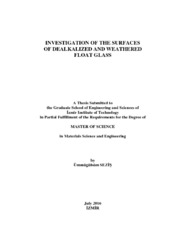Please use this identifier to cite or link to this item:
https://hdl.handle.net/11147/4862| Title: | Investigation Od the Surfaces of Dealkalized and Wethered Float Glass | Other Titles: | Alkalisi Giderilmiş, Hava ve Neme Maruz Kalmış Düz Camların Yüzeylerinin İncelenmesi | Authors: | Seziş, Ümmügülsüm | Advisors: | Şentürk, Ufuk Zareie, Hadi M. |
Keywords: | Float glass Atomic force microscopy Surface topography Sodium sulfate Glass corrosion Weathering |
Publisher: | Izmir Institute of Technology Izmir Institute of Technology |
Source: | Seziş, Ü. (2016). Investigation od the surfaces of dealkalized and wethered float glass. Unpublished master's thesis, İzmir Institute of Technology, İzmir, Turkey | Abstract: | In this study, the effects of surface dealkalization due to SO2 or SO3 gas treatment of commercial soda lime silica float glass on the weathering behavior was investigated. Only the air side of the glass was studied. The changes in the glass surface were analyzed for their topography and structure. The surface topography was studied using atomic force microscopy (AFM). The findings show the formation of micro-cracks on the surfaces of as-produced glass surfaces when treated with sulfur gas. The weathered surfaces show an increased roughness with increased weathering. The surface structure was investigated using attenuated total reflection-Fourier transform infrared (ATR-FTIR) spectroscopy, specular reflectance infrared (SR-IR) spectroscopy, and micro-Raman spectroscopy techniques The results of the studies, ATR-FTIR and SR-IR techniques provided a reasonable insight on the surface structural changes while micro-Raman spectroscopy failed to detects these differences. ATR-FTIR and SR-IR the overall comparison of the effects of peak position with and without sulfur gas treatment suggests a wide scatter within each group. This scatter implies that sulfur gas treatment does not have any statistically significant effects. Also, the change in peak positions are no clear evidence of a decreasing or increasing peak position as the weathering period is increased by weathering effect. Additionally, the calculated penetration depth is found to be ~0,6-1 μm for these techniques. Namely, the penetration depth greater than the surface modification was observed. The results showed was not significantly affected by the surface dealkalization and weathering reactions. The analysis of the surface topography using AFM technique showed the formation of micro-cracks like features on the surfaces of sulfur treated glasses. These features are thought to occur under the sodium sulfate salt residue that is formed during the high temperature dealkalization reactions on the surface. Results sample preparation, i.e. cleaning, was found to have a significant effect on the surface properties. A method has been developed to minimize the effects of sample preparation on the surface of the glass. Bu çalışmada, float metodu ile üretilen düz camların nem ortamındaki korozyon davranışları ve SO2/SO3 gaz dealkalizasyonunun bu camlar üzerine etkileri incelenmiştir. Bu çalışma için camın sadece hava yüzeyi kullanılmıştır, camın kalay yüzeyinde bir inceleme yapılmamıştır ve genel olarak dealkalizasyon işlemi uygulanmış ve uygulanmamış olmak üzere iki farklı tip numune kullanılmıştır. Nemli ortamda cam yüzey değişimleri üzerine yüzey temizleme işlemlerinin ve dealkalizasyonun etkileri detaylı bir şekilde ele alınmıştır. Ayrıca yaşlandırma öncesi ve sonrası cam yüzey yapı ve topografya değişimleri incelenmiştir. Yüzey topografyası atomik kuvvet mikroskobu (AFM), yüzey yapısı ise attenuated total reflection-fourier transform infrared (ATR-FTIR) spektroskopi, specular reflectance infrared (SR-IR) spektroskopi ve micro-Raman spectroskopi teknikleri kullanılarak araştırılmıştır. Bu çalışma sonucunda, ATR-FTIR ve SR-IR analiz sonuçları yaşlandırma etkisi hakkında bilgi verirken micro-Raman analizleri bu çalışma için sonuç vermemiştir. ATR-FTIR ve SR-IR analizleri için hesaplanan penetrasyon derinliği yaşlanma sonucu cam yüzeyinde meydana gelen değişimden büyüktür. ATR-FTIR ve SR-IR sonuçları incelenirken buna dikkat edilmelidir. Bu çalışmada AFM analiz sonuçları göstermiştir ki etanol yüzeyde giderilmesi güç bir film oluşturmuştur ve bu sebeple yüzey temizliği için kimyasal sıvı olarak izopropil alkol kullanılmıştır. Ayrıca, AFM analiz sonuçları sülfür gazı uygulaması yapılan cam yüzeylerde yaklaşık 2 nm derinliğinde çatlaklar olduğunu göstermiştir. Bu çatlakların sülfürleme sonucu yüzeyde oluşan sodyum tuzlarının altında olduğu düşünülmektedir. |
Description: | Thesis (Master)--Izmir Institute of Technology, Materials Science and Engineering, Izmir, 2016 Full text release delayed at author's request until 2017.08.12 Includes bibliographical references (leaves: 70-74) Text in English; Abstract: Turkish and English xii, 87 leaves |
URI: | http://hdl.handle.net/11147/4862 |
| Appears in Collections: | Master Degree / Yüksek Lisans Tezleri |
Files in This Item:
| File | Description | Size | Format | |
|---|---|---|---|---|
| T001519.pdf | MasterThesis | 3.49 MB | Adobe PDF |  View/Open |
CORE Recommender
Page view(s)
316
checked on Apr 14, 2025
Download(s)
364
checked on Apr 14, 2025
Google ScholarTM
Check
Items in GCRIS Repository are protected by copyright, with all rights reserved, unless otherwise indicated.